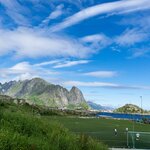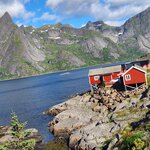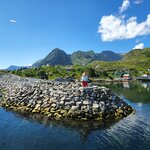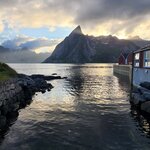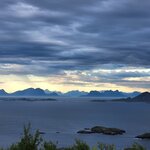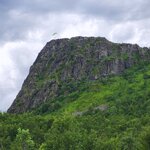Seeing the Northern Lights over the snowy Norwegian landscape feels like hitting the lottery. The red, green, and purple ribbons seem to come out of hiding, saying hello with a dance and a song that's always too fleeting. If you time it right, you can witness it. Here's how.
Where Should I Go?

Alta (the largest town in Finnmark) is a great port to wherever you want to go to see the auroras. Hammerfest, Vardø, Kirkenes, and Karasjok are other good options in the area — they're all around 70° latitude, and you'll find tour operators in every town. Once you're up here, lights chasers tend to go to one of three areas: the fjords, towards the glacier, or on the Finnmarksvidda plateau. It usually depends on the conditions on any given night.
You could also wander over to Nordkapp if you're looking for something ridiculously remote, but there are two things to consider: it's rather hard to get to (you'll have to find the right operator at the right time), and the weather is notoriously bad. The lights may be putting on an amazing show, but you won't know it through the fog and snow. If you happen to be in the area when the weather looks good, this might be an option, though you'll be pressing your luck.
When Should I Go?

Up in the Alta region, the Northern Lights pretty much correlate to dark, clear skies. In summer, when the sun never sets? Nothing. Cold, clear, wintery nights? Bingo. September into March (possibly into the beginning of April) is the season, and if you give yourself a few days, odds are you'll see them eventually.
Deeper into the winter you're going to have colder temperatures, but you'll also get better rates and see fewer tourists. September and March — the bookends of the season — may make your success rate less of a sure thing.
Chat with a local specialist who can help organize your trip.
Joining a Tour

The absolute simplest way to see the Northern Lights in Norway is to join a tour. There will be plenty of options out of any of these towns, and this is where it's important to know your choices: You could wind up on a large bus, completely defeating the purpose of "beating the crowds," or you could wind up with three or four other people (or even alone). There are fat-biking aurora tours, dogsledding aurora tours, and private tours, too. Just because you're on a "tour" doesn't necessitate awkward groups, large buses, lots of camera flashes, and time constraints. Do your research (or let kimkim do it for you), and you'll wind up where you want to be.
Going on Your Own

There are two rules when it comes to chasing the auroras on your own: be safe and be prepared.
When it comes to being safe, do your research beforehand. Find out where the lights are rumored to be strongest (onshore winds make viewing along the water better, for example), plot your route (this includes trails), keep plenty of gas and food in the car, and bring plenty of layers (and a map!).
There are a dozen websites that predict when and where the lights will show up, and locals will have expertise to offer as well. Make a Plan B, just in case your first night doesn't pan out. In addition to preparing for nature's whims, prepare for her requirements, too — in other words, pack extra wool socks.
What Else Can I Do?

So many things. For starters, the area around Alta is absolutely beautiful (and if you're assuming it's like Tromsø, it's actually not — think far more spruce trees, and everything covered in a delicate layer of frost). You could spend hours just driving around, gazing at your surroundings.
Or you could go dog sledding. Trasti and Trine has tons of adorable huskies, plus a restaurant and hotel on site. You'll come back from mushing with your team over river ice, the mountain plateau, or through the forest, and come "home" to bread straight from the oven and fish straight from the fjord. Another option is Holmen Husky — they have a handful of modified lavvus (traditional tents of the indigenous Sami people) with glass walls for viewing the auroras.
And then there's the museums: The Alta Museum, which has the largest concentration of rock art made by hunter-gatherers in Northern Europe, is worth a stop before heading out to Karasjok. This is one of the hubs of Sami culture, and you'll get a good 101 course by visiting the Sami National Museum (you can also tour the Sami Parliament while here). If you want more, make your way to the Sápmi Culture Park, where you can enjoy traditional music and try Sami cuisine around a roaring fire.
If you've got more time to spare, consider going on a king crab safari, going ice fishing, or heading to the small village of Honningsvåg. Think colorful houses, cod-drying racks, and charming cafés. And the best part? In winter, it's still incredibly quiet.
Things to Keep in Mind

In general, the further north you go, the better your odds (again, see the beginning of this article). Your chances also improve the further from the coast you go (water tends to bring fog, snow, and strange weather patterns). That being said, the coast can be an absolutely fantastic spot for viewing the auroras if your skies are clear. Factor in mountains to your equation, too; Alta may be near the water, but the elevation that surrounds it staves off the negative effects.
In short, the best way to increase your odds is to plan a few nights for this experience. Time and weather are what's against you here, not the lights themselves. The more patience you have, the better. If you're patient, the odds of you having some kind of aurora experience — at least up here in the Alta region in winter — are high.

